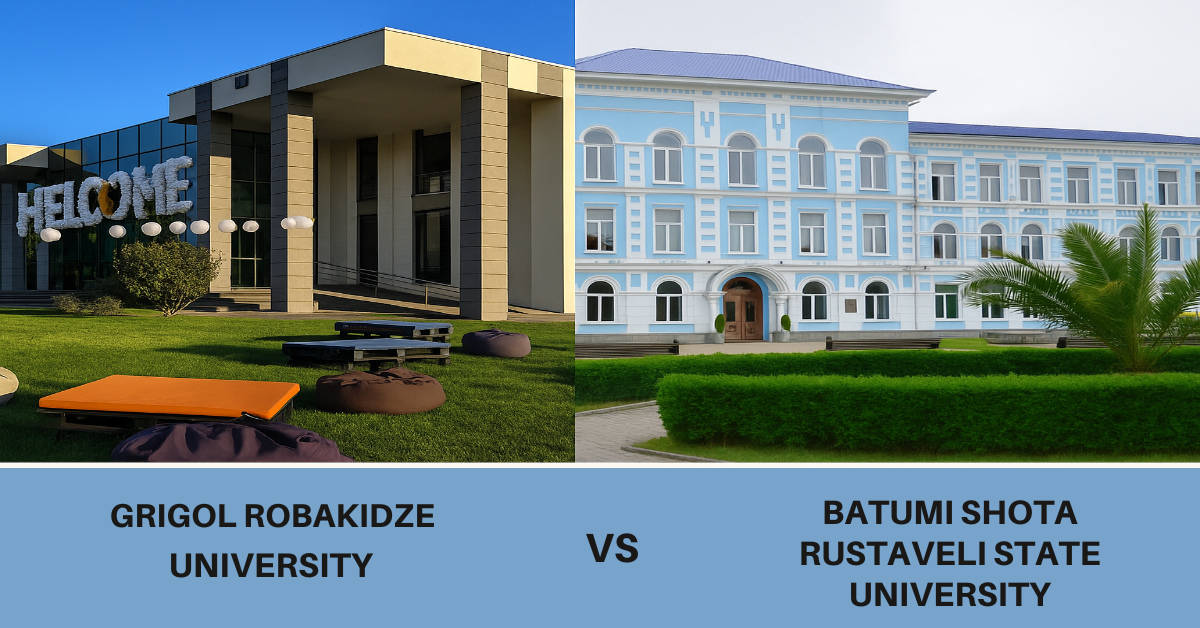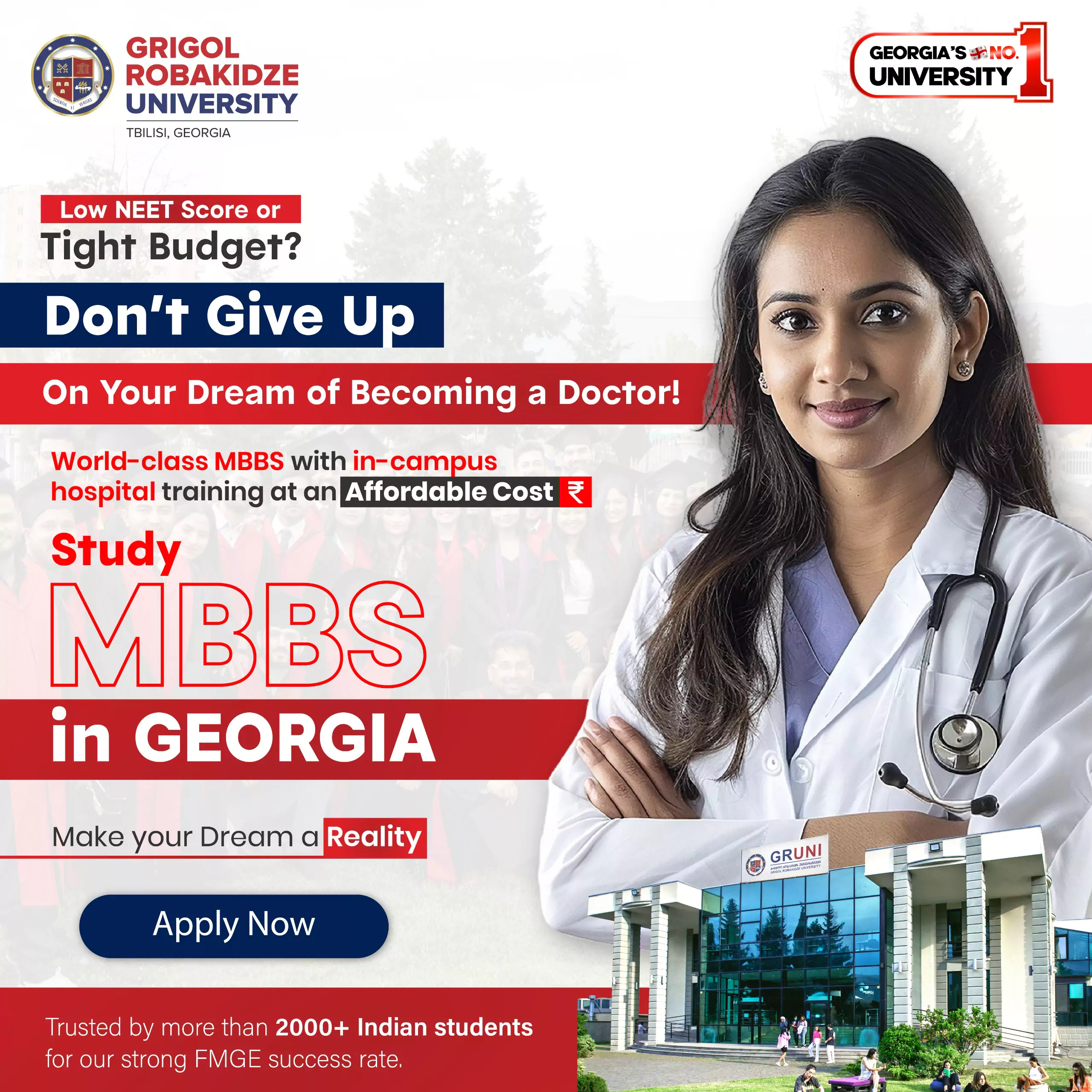Summary:
- GRUNI offers structured academics with early clinical exposure
- BSU is a public university with budget-friendly coastal appeal
- GRUNI excels in FMGE support and Indian student services
- The ideal choice depends on your learning style and career goals
- Choose based on the support system and clinical goals
Georgia, located between the Black Sea and the Caucasus Mountains, provides a serene and peaceful environment for education. Soon, it became a dream destination for Indian students wanting to study MBBS abroad. Among the universities aligned with the NMC-approved medical course format, Grigol Robakidze University (GRUNI) in Tbilisi and Batumi Shota Rustaveli State University (BSU) in Batumi are popular choices.
While Grigol Robakidze University (GRUNI) provide extra and personalised support for international students, particularly Indians whereas Batumi Shota Rustaveli State University (BSU) is a public institution which don’t have separate facilities for Indian students.
In this article, we compare GRUNI and BSU across academic and clinical aspects to help students make an informed decision, especially those targeting FMGE in India or global career pathways.
Grigol Robakidze University Vs Batumi Shota Rustaveli State University: Quick Comparison
| Parameter | Grigol Robakidze University (GRUNI) | Batumi Shota Rustaveli State University (BSU) |
| Location | Tbilisi (Capital city of Georgia) | Batumi (Coastal city, Black Sea region) |
| University Type | Private | Government/Public |
| Established | 1992 | 1945 |
| NMC Approved | Yes | Yes |
| WDOMS Listed | Yes | Yes |
| Medium of Instruction | Fully English | Fully English |
| Course Duration | 6 Years (incl. internship) | 6 Years (incl. internship) |
| FMGE Focus/Support | Moderate: FMGE supports improving | Moderate: FMGE support improving |
| Indian Students’ Community | Large and growing rapidly | Moderate but consistent |
| Clinical Training | Starts from 3rd year in Tbilisi hospitals | Final year hospital internship in Batumi region |
| Infrastructure | Modern labs, smart classrooms, simulators | Spacious campus, good labs, access to public hospitals |
| Indian Mess & Hostel | Yes (on-campus hostel + Indian food) | No ( but separate hostels and Indian food nearby) |
| Student Support Cell | Dedicated Indian Students Cell | General International Office |
| Ideal For | NEET-qualified students seeking structure + support | Budget-conscious students who prefer peaceful environments |
| City Advantage | Capital city, well-connected, multicultural hub | Calm, scenic city with lower cost of living |
| Admission Competitiveness | Moderate (Seats filling fast due to rising demand) | Lower competition, easier seat availability |
| Popular Quote | “GRUNI feels like a mini-India with global standards” | “Study medicine by the sea in a calm, student-friendly city” |
Note: While BSU shows slightly higher numbers, GRUNI has shown remarkable consistency and growth, especially among private universities. Its rising trend reflects strong academic support tailored for Indian students.
Grigol Robakidze University Vs Batumi Shota Rustaveli State University: Academic Quality
Grigol Robakidze University (GRUNI) stands out for its structured, student-centric curriculum in academic quality. The medium of instruction is English, and the university integrates modern teaching methods like simulation-based learning, smart classrooms, and regular assessments aligned with NMC and FMGE.
GRUNI also offers better academic support for Indian students, including doubt-clearing sessions, NEET PG/FMGE prep modules, and mentorship.
On the other hand, Batumi Shota Rustaveli State University (BSU), being a public university, offers a more traditional academic approach, with a strong theoretical base and experienced Georgian faculty. While BSU maintains solid academic standards, its pace and teaching style may feel rigid for students needing more structured guidance.
Grigol Robakidze University Vs Batumi Shota Rustaveli State University: Academic Exposure Comparison
| Parameter | Grigol Robakidze University (GRUNI) | Batumi Shota Rustaveli State University (BSU) |
| Syllabus Structure | 6-year MD program (360 ECTS), NMC-compliant with early clinical exposure | 6-year MD program based on Bologna Process standards |
| FMGE/NExT Preparation | Regular mock tests, Indian-style teaching methods, FMGE coaching support | General academic model; FMGE support available but not structured |
| Faculty–Student Ratio | Approx. 1:30 (small batches = individual attention) | Approx. 1:15 (public university, larger batches) |
| Laboratories & Facilities | Smart classrooms, anatomy & histology labs, simulation training centers | Regular mock tests, Indian-style teaching methods, and FMGE coaching support |
| Research Opportunities | Active research culture, medical publications, and conferences | Strong research backing with government and international tie-ups |
| PhD-Qualified Faculty | Yes, several departments with doctoral-level teaching staff | Yes, especially in pre-clinical and research departments |
Overall, GRUNI’s personalised academic ecosystem gives it an edge for Indian students seeking focused, outcome-based medical education.
Grigol Robakidze University Vs Batumi Shota Rustaveli State University: Clinical Exposure
When it comes to clinical exposure, Grigol Robakidze University (GRUNI) offers a more structured and early-start approach compared to Batumi Shota Rustaveli State University (BSU).
At GRUNI, Indian students begin hands-on patient interaction from the 3rd year itself in affiliated hospitals across Tbilisi, ensuring gradual skill development alongside theoretical learning. The university’s emphasis on simulation-based training and modern anatomy labs also prepares students better for real-world scenarios.
In contrast, BSU, being a government institution, primarily offers clinical training in the final year, which, although comprehensive, may feel rushed for some students. While both universities meet NMC guidelines, GRUNI’s early and continuous exposure gives students an edge, especially those aiming to clear FMGE.
GRUNI vs BSU: Clinical Capacity Comparison
| Parameter | GRUNI | BSU |
| Clinical Rotations Start | From 3th year onwards | Included in the final year; simulation labs enhance readiness |
| Affiliated Hospitals | From the 4th year onwards | Batumi Republican Hospital + regional health centers |
| OPD & Bed Strength | Steady urban patient inflow; medium-sized hospitals ensure hands-on training | Lower patient volume due to Batumi’s smaller population |
| ICU/Emergency Rotation | Small group mentoring, easier access to real-time procedures | Covered in later semesters; real-case exposure may vary |
| Mentoring & Clinical Access | Present in key specialities (medicine, surgery, pharmacology) | Quality training, but larger student groups may limit exposure |
| PhD Clinical Faculty | Present in key specialties (medicine, surgery, pharmacology) | Present; largely in public hospital departments |
Read Also: Grigol Robakidze University Vs Tbilisi State Medical University: A Comprehensive Comparison
GRUNI vs BSU: Tuition Fees & Living Costs
| Feature | GRUNI (Tbilisi) | BSU (Batumi) |
| Annual Tuition Fee | ~USD 5,500 | ~USD 5,000 |
| Total Cost (6 Years) | ~USD 34,000-40,000 | ~USD 34,000–38,000 |
| Hostel Facility | Available; USD 2,500 per year | Available; similar cost |
| Monthly Living Cost | USD 200–300 | USD 200–250 |
| Indian Food Available | Yes | Yes |
GRUNI offers a cost-effective MBBS in the capital city without compromising infrastructure or academic quality.
GRUNI vs BSU: FMGE Passing Rate Comparison (India)
| Year | GRUNI Pass % | BSU Pass % |
| 2021 | 17.5% | 24.0% |
| 2022 | 30.8% | 33.8% |
| 2023 | 20.7% | 22.3% |
| 2024 | 21% | 40% |
GRUNI vs BSU: Student Life, Environment & Support
| Feature | GRUNI | BSU |
| City | Tbilisi (Capital, Urban, Advanced Medical Network) | Batumi (Coastal, Smaller City) |
| Student Support | Dedicated Indian support cell, FMGE counselling | General support cell, academic guidance |
| Safety & Comfort | High, quiet surroundings and relaxed pace | Minimal; some Georgian communication is needed in clinics |
| Language Barrier | Minimal; English-taught program | Moderate; some Georgian communication is needed in clinics |
Why Grigol Robakidze University is a Smarter Choice
- Focused FMGE Support: Regular mock tests and preparation assistance increase passing chances for Indian students.
- Personalised Learning: Small batch sizes = more one-on-one time with faculty and clinical mentors.
- Modern Infrastructure: Smart classrooms, simulation labs, and digital libraries boost learning outcomes.
- Clinical Confidence: Practical training begins early and continues with steady patient exposure.
- Cost & Location Advantage: Affordable education in Georgia’s capital, giving access to better medical networks and lifestyle.
What Indian Students Should Do?
Choose Grigol Robakidze University if you:
- Need an affordable MBBS in a modern capital city
- Prefer small, guided clinical rotations
- Seek personalised teaching in English
- Seek personalised teaching in English
Choose Batumi Shota Rustaveli State University if you:
- Prefer a public university with broader programs
- Are comfortable with medium-level clinical exposure
- Like to enjoy quiet coastal life in Batumi
Both GRUNI and BSU are recognised and respected universities for MBBS in Georgia. However, Grigol Robakidze University is the best for students who want structured academic growth, FMGE guidance, and a strong clinical foundation in a capital city setting. Its rising FMGE results, small class size, and dedicated mentoring make it a smart and strategic choice for aspiring doctors.
Read Also: A Day at Grigol Robakidze University (GRUNI) with Indian Students- Riya Sharma



